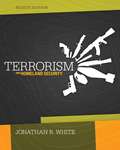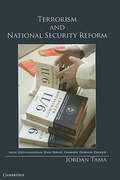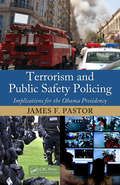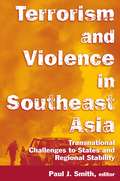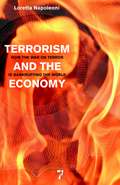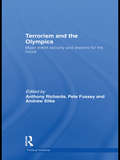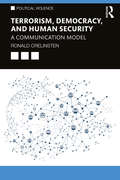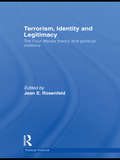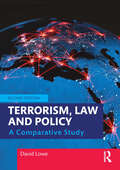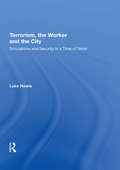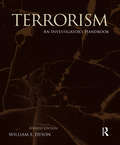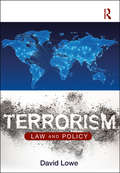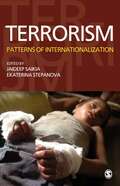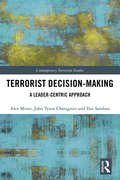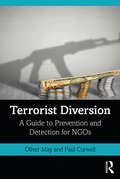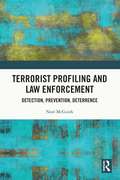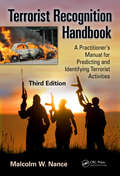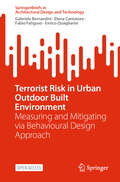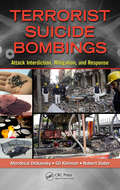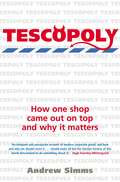- Table View
- List View
Terrorism and Homeland Security (Eighth Edition)
by Jonathan R. WhiteWritten by acclaimed national terrorism expert Jonathan R. White, the market-leading TERRORISM AND HOMELAND SECURITY is widely recognized as the most comprehensive, balanced, and objective terrorism book available. In the Eighth Edition, White continues to provide a theoretical and conceptual framework that enables readers to understand how terrorism arises and how it functions. Packed with cutting-edge coverage, the book discusses the most sophisticated theories of the world's best terrorist analysts, while still focusing on the domestic and international threat of terrorism and the basic security issues surrounding terrorism today.
Terrorism and National Security Reform
by Jordan TamaTerrorism and National Security Reform demonstrates that blue-ribbon commissions can be powerful vehicles for policy change, overturning the conventional wisdom that views them only as devices for passing the buck. Jordan Tama explains how the unique political credibility of commissions can enable them to forge bipartisan consensus on tough policy challenges. He also shows that commissions are most valuable during a crisis, when policymakers face pressure to make changes but frequently cannot agree on what to do. Using an original database, case studies, and more than 200 interviews of policymakers and commission participants, Tama reveals how commissions have shaped Barack Obama's plan for ending the Iraq War, spurred the largest government and intelligence overhauls since 1947, and driven many other elements of U.S. counterterrorism policy. In an era of unrelenting partisanship and extreme polarization, this book shows that commissions are increasingly valuable policymaking tools.
Terrorism and Public Safety Policing: Implications for the Obama Presidency
by James F. PastorThe trends, data, and battle-tested logic don't lie. A perfect storm of extremist ideologies is on the horizon that threatens to challenge the current state of public safety forcing police chiefs, public administrators, and security professionals to rethink their approach to policing the streets of America. Professor James Pastor, a recognized auth
Terrorism and Violence in Southeast Asia: Transnational Challenges to States and Regional Stability
by Paul J. SmithThis timely work examines the scale and root causes of terrorism across Southeast Asia, including the role of al-Qaeda's ascendancy in the region. It begins with an overview of the analytical and theoretical framework for discussing the subject. Individual chapters then examine terrorist activities from both functional and country-specific perspectives. The book traces fundamental linkages between terrorism and security issues, such as illegal immigration, narcotics trafficking, and other criminal activity. In addition, it considers the issue of convergence - the growing connection between criminal groups and terrorism, and how this may facilitate future violence. Written by a range of experts in the field, the individual chapters reflect a variety of perspectives. The contributions fall into two broad categories - chapters that directly address terrorism (the groups, their ideologies, their modus operandi, their origins, and state responses to them); and chapters that address the "enabling environment" that exists in Southeast Asia (the role of transnational crime, porous borders, convergence between terrorism and crime).
Terrorism and the Economy: How the War on Terror is Bankrupting the World
by Loretta NapoleoniEconomist and best-selling author Loretta Napoleoni traces the link between the finances of the war on terror and the global economic crisis, finding connections from Dubai to London to Las Vegas that politicians and the media have at best ignored. In launching military and propaganda wars in the Middle East, America overlooked the war of economic independence waged by Al-Qaeda. The Patriot Act boosted the black market economy, and the war on terror prompted a rise in oil prices that led to food riots and distracted governments from the trillion-dollar machinations of Wall Street. Consumers and taxpayers, spurred by propaganda fears, were lured into crushing global debt. Napoleoni shows that if we do not face up to the many serious connections between our response to 9/11 and the financial crisis, we will never work our way out of the looming global recession that now threatens our way of life.While we feared that Al-Qaeda might destroy our world, Wall Street ripped it apart.
Terrorism and the Olympics: Major Event Security and Lessons for the Future (Political Violence)
by Anthony RichardsThe book aims to outline the progress, problems and challenges of delivering a safe and secure Olympics in the context of the contemporary serious and enduring terrorist threat. The enormous media profile and symbolic significance of the Olympic Games, the history of terrorists aiming to use such high-profile events to advance their cause, and Al Qaeda's aim to cause mass casualties, all have major implications for the security of London 2012. Drawing on contributions from leading academics and practitioners in the field the book will assess the current terrorist threat, particularly focusing on terrorist targeting and how the Olympics might feature in this, before addressing particular response themes such as transport security, the role of surveillance, resilient designing of Olympic sites, the role of private security, and the challenge of inter-agency coordination. The book will conclude by providing an assessment of the legacy of Olympic security to date and will discuss the anticipated issues and dilemmas of the future. This book will be of interest to students of terrorism studies, security studies, counter-terrorism and sports studies.
Terrorism, Democracy, and Human Security: A Communication Model (Political Violence)
by Ronald CrelinstenThis book examines the relationship between terrorism and counterterrorism and how it operates within the broader context of communication, control, power, and democratic governance at the national, international, and transnational level. A culmination of decades of research on the challenges that liberal democracies face in dealing with terrorism, this work provides an innovative framework that maps out the broader context in which terrorism and counterterrorism interact and co-evolve – the terrorism–counterterrorism nexus. In a series of models moving from local to global perspectives, the framework places this nexus within the broader context of social, cultural, political, and economic life. This framework provides a tool for maintaining situational awareness in a multi-tiered, networked world where geography and history are splintering into a rainbow of perspectives and locales, revealing the contested nature of space and time themselves. This book will be of much interest to students of political violence, terrorism studies, communication studies, and international relations, as well as security professionals.
Terrorism, Identity and Legitimacy: The Four Waves theory and political violence (Political Violence)
by Jean E. RosenfeldThis book argues that terrorism in the modern world has occurred in four "waves" of forty years each. It offers evidence-based explanations of terrorism, national identity, and political legitimacy by leading scholars from various disciplines with contrasting perspectives on political violence. Whether violence is local or global, it tends to be both patterned and innovative. It elicits chaos, but can be understood by the application of new models or theories, depending upon the methods and data experts employ. The contributors in this volume apply their experiences and studies of terrorists, mob violence, fashions in international and political violence, religion’s role in terrorism and violence, the relationship between technology and terror, a recurring paradigm of terrorist waves, nation-states struggling to establish democratic/elective governments, and factions competing for control within states - in order to make sense of both national and international acts of political violence and to ask and answer some of the most disturbing questions these phenomena present. This book will be of much interest to students of terrorism, religion and violence, nationalism, sociology, war and conflict studies and IR in general.
Terrorism, Law and Policy: A Comparative Study
by David LoweTerrorism, Law and Policy: A Comparative Study is a textbook offering a comparative study of the terrorism-related legislation, policy and practice introduced from international governmental bodies such as the UN and the European Union, and individual states, with a focus on Australia, Canada, New Zealand, the UK and the US. It offers a uniquely legal perspective on key themes relating to terrorism and security. This new edition is brought fully up to date with the ever-changing developments in terrorist activity, as well as in states’ approaches to anti-terrorism legislation and policy. It includes new chapters on the far-right and extreme far-right cause, one on offering a comparative study of the anti-terrorism policies of states and international bodies, and the role of international and national counter-terrorism agencies, planning and preparing acts of terrorism and a new chapter on freedom of expression, hate crime and proscribing groups as terrorist organisations. Terrorism, Law and Policy: A Comparative Study is ideally suited for terrorism and security modules at undergraduate and postgraduate levels, and will also be of interest to practitioners working on the legal aspects of these areas.
Terrorism, the Worker and the City: Simulations and Security in a Time of Terror
by Luke HowieSoon after watching the twin towers falling in New York, some of those with business responsibilities were already asking themselves whether people would be willing to work in tall buildings ever again. Is work too risky? How can people be expected to attend work in what might now be seen as precarious and vulnerable workplaces and cities? Although, thankfully, large scale terrorist attacks are infrequent, the world's cities, and the businesses to which they are home, have been put on notice that it can come to any place at any time. In Terrorism, the Worker and the City, Luke Howie considers what steps managers and employees can and should take to protect their businesses from such an amorphous and indefinable threat. Deftly combining theoretical insight with empirical research, he reveals how, despite an appearance of 'business as usual', fear; anxiety; and suspicion permeate workplaces, even in cities that may not be at the top of any terrorist group's target list. Using the Australian city of Melbourne, a cosmopolitan city and major business centre with nearly four million people, as a metaphor for other such cities around the world, Dr Howie's research has uncovered that even where they don't perceive a high level threat, business managers who might face having to account for themselves to some post event Inquiry have taken action in consequence of the situation. Often, that action amounts to the introduction of what can be described as 'Simulated Security'. This cannot ever provide certain protection from terrorist attack, but it may be the best we can reasonably do. There is also evidence that it can be effective in terms of providing the reassurance to counter the terrorist objective of disrupting normal life through fear. With its rigorous research compared with other more speculative works on this subject, Terrorism, the Worker and the City will appeal to city and business leaders and managers, and security professionals, as well as those in governmenta
Terrorism: An Investigator's Handbook
by William E. DysonThis handbook introduces the reader to the field of terrorism investigation. Describing how terrorists operate and how they differ from other criminals, it provides an outline of how terrorism investigations should be conducted. By helping investigators to develop skills and knowledge, this guide helps them to prepare prosecutable cases against terrorists.
Terrorism: Law and Policy
by David LoweTerrorism: Law and Policy provides a comprehensive socio-legal analysis of issues related to terrorist activity. Aimed at both undergraduate and postgraduate students, the book takes a comparative approach to the law related to terrorism in a number of states, mainly those in Europe, North America, Australia and New Zealand. Beginning with an examination of the background to various currently active terrorist groups, the book focuses on those groups which are currently active and which pose a threat to security, especially at the international level. The chapters take the reader through the legal definitions of terrorism contained in various states’ statutory provisions and examine how the courts have interpreted terrorism in those states’ jurisdictions. The main aim of any terrorist investigation is prevention and so the book examines the various statutory preventative measures that states have introduced and explores the legal issues surrounding surveillance, terrorism intelligence exchange, radicalisation, use of social media, quasi-criminal provisions, asset-freezing and the nexus between terrorist activity and organised crime. Bringing together a number of themes related to terrorism and security from a uniquely legal perspective, this book builds a comparative picture of the legal counter-terrorism interventions states are adopting to increase co-operation and adopt a more united approach in the face of the international terrorism threat.
Terrorism: Patterns of Internationalization
by JAIDEEP SAIKIA EKATERINA STEPANOVATerrorism: Patterns of Internationalization provides a systematic analysis of the concepts of internationalization of terrorism. It looks into the stages and processes through which terrorism has developed in various parts of the world and binds together the facts to present a comprehensive picture of the distinguishing features that characterize the internationalization of terrorism-from local to global. Through 11 well-researched chapters, leading experts on terrorism from across five continents express their views and analyze the main patterns, stages, and levels of internationalization of different types of terrorism in a broad cross-regional perspective. The book challenges a number of conventional patterns of analysis and underlines the importance of visualizing terrorism as an act driven by political motivation, notwithstanding the fact that it is manifested through ideological or religious sentiments. It also analyzes the various tactics used by different terrorist organizations in different regions and distinguishes terrorists from other non-state actors. It dwells on the dangerous implications of the internationalization of terrorism and emphasizes the need to develop a research methodology which can help understand the current conceptualization of the phenomenon and bring forward analytical solutions. This will be an important sourcebook for the military, the police, law enforcement agencies, and government training institutes. In addition, it will also benefit political analysts and professionals such as counter-insurgency and anti-terrorism experts.
Terrorist Decision-Making: A Leader-Centric Approach (Contemporary Terrorism Studies)
by Alex Mintz Tyson Chatagnier Yair SambanThis book analyzes a series of decisions by leaders of three major terrorist organizations and identifies a unique "Decision DNA" for each of them. The authors use the Applied Decision Analysis methodology to examine organizational and operational decisions made by the leaders of three major groups: Hezbollah (Hassan Nasrallah), Hamas (Khaled Mashal), and al-Qaeda (Osama bin Laden). Decisions that were of critical importance to each organization are identified and anaylzed, to uncover the particular decision rule employed by the leader in question and to establish their "Decision DNA." A Decision DNA is unique to each leader and can be used to explain previous decisions or predict future choices. The authors demonstrate that the findings presented can be used to promote effective counterterrorism measures, and they provide a series of policy implications that arise from their examination of each leader. This book will be of much interest to students of terrorist studies, political violence, security studies, and Middle Eastern politics.
Terrorist Diversion: A Guide to Prevention and Detection for NGOs
by Oliver May Paul CurwellMany of the world’s 40,000 International NGOs (INGOs) work in places where terrorist financing, sanctions breaches, and diversion are key risks. Almost all of the top ten recipient countries of humanitarian aid alone in 2015 were high-risk jurisdictions, for example, receiving more than £7bn between them. When they feel safe to speak, sector workers share sobering stories about what might have happened to some of this money. As INGOs struggle to keep up with worsening humanitarian needs, diversion risks and their complexity remain daunting. The demands of internal stakeholders, donors, banks, and regulators are diverse and even contradictory. Public scrutiny has magnified, but is not always well-informed. Institutional donors transfer ever more risk to implementing partners, while some banks seek to avoid this business altogether, pushing some NGOs outside the global banking system. Looming over all of these converging pressures is a latticework of austere international sanctions and counter-terror regimes. It is no surprise that INGOs find themselves struggling to reconcile this complex set of expectations with their charitable missions. Yet the consequences of failing to do so can be severe; future funding is contingent on reputation, and serious offences litter the regulatory landscape. The implications of breaches can be existential for organisations and criminal for individuals. Terrorist Diversion: A Guide to Prevention and Detection for NGOs is an accessible, pragmatic guide for international NGOs of all shapes and sizes. Clearly explaining the nature of the challenge, and setting out a programme to meet it, it explores how it is possible for INGOs to manage these risks more effectively through their missions – not in spite of them.
Terrorist Profiling and Law Enforcement: Detection, Prevention, Deterrence
by Noel McGuirkThis book analyses the usefulness of terrorist profiling utilised by law enforcement officers as a pre-emptive means to assist them in the detection, prevention and deterrence of terrorism and/or its preparatory activities. It explores two main themes arising from the phenomenon of terrorist profiling: the lawfulness of terrorist profiling and the utility of profiling. These two themes are explored in three separate parts. Firstly, the book begins by drawing upon human rights concerns arising from the use of terrorist profiling by law enforcement officers. Secondly, an analytical framework capable of making determinations on the usefulness of terrorist profiling. This framework develops a profiling spectrum that ranges from formal and informal manifestations of terrorist profiling that forms the basis for evaluating its usefulness. Finally, the book presents an examination of various manifestations of terrorist profiling by separating the analysis of the ‘construction’ of profiles on the one hand, from their ‘application,’ on the other, so as to be able to identify and examine profiling’s usefulness as a technique to assist law enforcement officers make predictions about likely offender characteristics. This book ultimately concludes that terrorist profiling should only be conducted by undertaking a systematic assessment of the construction of profiles separate from the application of profiles whilst simultaneously taking into account fundamental human rights concerns with the practice of terrorist profiling. The work will be an essential resource for academics, law enforcement officers and lawyers in the disciplines of law, criminology, human rights, criminal justice and policing. As the book engages with terrorist profiling, it will also be of interest to those engaged in the psychology of terrorism.
Terrorist Recognition Handbook: A Practitioner's Manual for Predicting and Identifying Terrorist Activities, Third Edition
by Malcolm W. Nance Desmond WengerFirst published in 2003, Terrorist Recognition Handbook: A Practitioner's Manual for Predicting and Identifying Terrorist Activities remains one of the only books available to provide detailed information on terrorist methodology revealing terrorist motivation, organizational structure, planning, financing, and operational tactics to carry out atta
Terrorist Risk in Urban Outdoor Built Environment: Measuring and Mitigating via Behavioural Design Approach (SpringerBriefs in Architectural Design and Technology)
by Gabriele Bernardini Fabio Fatiguso Enrico Quagliarini Elena CantatoreThis open access book outlines the latest results in analysing, assessing, and managing terrorist risk in the urban outdoor built environment. In detail, contents refer to the outdoor Open Areas (such as streets, squares, urban parks and other public spaces in our cities) exposed to such violent events considering the physical elements and properties of the built environment and users. PThe built environment features, including layout, use and management, are combined with terrorist threats issues and user behaviours in emergency conditions, to determine a set of complementary tools for the reduction of risk and increase of urban resilience. The contents hence provide different levels of tool analysis, for risk scenario definition, risk assessment, mitigation strategies design and effectiveness evaluation, considering traditional approaches about the issue along with simulation-based approaches relying on understanding and representing user behaviors. This “behavioural design” approach offers the opportunity to manage the level of risk for specific real urban cases over going the normative limitations in Europe that are only referred to few countries and sometimes deal with the prevention of violent acts by intelligence activities as the exclusive way to face this issue. In addition, the focus on the characters of cultural and historic places and their resilience is increasing by means of introduction of mitigation and compatible solutions providing a complementary chapter for the design of resilient cities in all of their peculiarities (peripheries, consolidated, and historical). In this sense, it is one of the first organized attempts to analyse the main limitations of current solutions in these outdoor Open Areas and, at the same time, to clearly introduce the importance of human behaviours and the various choices in emergency evacuation conditions, thanks to the proposed behavioural-based simulation approach. The attention is focused on a critical aspect for historic spaces, where morphological conditions are fixed values. Thus, this book represents a sort of guidelines about these user-related issues during such violent events and is useful to both professionals and researchers in the areas of security and urban administration.
Terrorist Suicide Bombings: Attack Interdiction, Mitigation, and Response
by Robert Slater Mordecai Dzikansky Gil KleimanUrban environments are prime targets for suicide bombings over the next decade. While the threat may be ever-present, measures are available that can empower law enforcement personnel to thwart attacks, or at least mitigate the effects by reducing casualties. Written by professionals with first-hand experience, Terrorist Suicide Bombings: Attack In
Tesco Group Food
by Mary Shelman Jose B. Alvarez Damien P. McloughlinIn 2010, the world's third largest retailer created a new centralized sourcing department for fresh food and store-brand grocery products in response to changes in global supply and to better meet the needs of a new multi-channel retail environment. The case, set in late 2013, covers the development of Tesco Group Food and identifies future opportunities and challenges.
Tesco PLC: Fresh & Easy in the United States
by John A. QuelchTesco, the world's third largest retailer, is facing problems with its launch of a new retail chain in the U.S.A.
Tesco PLC: Fresh & Easy in the United States
by John A. QuelchTesco, the world's third largest retailer, is facing problems with its launch of a new retail chain in the U.S.A.
Tesco Plc.
by David E. BellTesco, a supermarket chain, has been transformed from a third-rate retailer to a global leader in the past ten years. This case describes how that was accomplished. Interviews with Tesco employees explain the company's approach to understanding customers, motivating employees, succeeding on the Internet, and creating an international strategy.
Tescopoly: How One Shop Came Out On Top And Why It Matters
by Andrew SimmsYou can shop anywhere you like -- as long as it's Tesco The inexorable rise of supermarkets is big news but have we really taken on board what this means for our daily lives, and those of our children? In this searing analysis Andrew Simms, director of the acclaimed think-and-do-tank the New Economics Foundation and the person responsible for introducing 'Clone Towns' into our vernacular, tackles a subject none of us can afford to ignore. The book shows how the supermarkets -- and Tesco in particular -- have brought: " Banality -- homogenized high streets full of clone stores " Ghost towns -- superstores have drained the life from our town centres and communities " A Supermarket State -- this new commercial nanny state that knows more about you than you think " Profits from poverty -- shelves full of global plunder, produced for a pittance " Global food domination -- as the superstores expand overseas But there's change afoot, with evidence of the tide turning and consumer campaigns gaining ground. Simms ends with suggestions for change and coporate reformation to safeguard our communities and environment -- all over the world. This book has been written and published independently from the Tescopoly Alliance and is not endorsed by them.
Tescopoly: How One Shop Came Out on Top and Why it Matters
by Andrew SimmsYou can shop anywhere you like -- as long as it's Tesco The inexorable rise of supermarkets is big news but have we really taken on board what this means for our daily lives, and those of our children? In this searing analysis Andrew Simms, director of the acclaimed think-and-do-tank the New Economics Foundation and the person responsible for introducing 'Clone Towns' into our vernacular, tackles a subject none of us can afford to ignore. The book shows how the supermarkets -- and Tesco in particular -- have brought: " Banality -- homogenized high streets full of clone stores " Ghost towns -- superstores have drained the life from our town centres and communities " A Supermarket State -- this new commercial nanny state that knows more about you than you think " Profits from poverty -- shelves full of global plunder, produced for a pittance " Global food domination -- as the superstores expand overseas But there's change afoot, with evidence of the tide turning and consumer campaigns gaining ground. Simms ends with suggestions for change and coporate reformation to safeguard our communities and environment -- all over the world. This book has been written and published independently from the Tescopoly Alliance and is not endorsed by them.
